

"Eco-Friendly" Mobile Phone Runs on Coke. Eco-friendly phone for Nokia by Daizi Zheng. Chinese designer Daizi Zheng has created a conceptual mobile phone for Finnish brand Nokia that could be powered by sugary drinks.
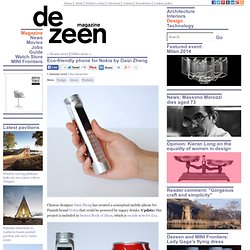
Update: this project is included in Dezeen Book of Ideas, which is on sale now for £12. Modified Mobile Phone Runs on Coca-Cola. Daizi Zheng, a Chinese developer who is currently based in London, has modified a Nokia cell phone to run on Coca-Cola or any other sugary solution.
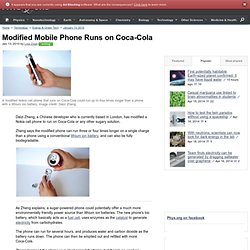
Zheng says the modified phone can run three or four times longer on a single charge than a phone using a conventional lithium ion battery, and can also be fully biodegradable. As Zheng explains, a sugar-powered phone could potentially offer a much more environmentally friendly power source than lithium ion batteries. The new phone's bio battery, which basically acts as a fuel cell, uses enzymes as the catalyst to generate electricity from carbohydrates.
The phone can run for several hours, and produces water and carbon dioxide as the battery runs down. The phone can then be emptied out and refilled with more Coca-Cola. Daizi Zheng: Coco-cola Phone. Coca Cola-powered Nokia Phone. Sick of charging up your Nokia on a regular basis?

Designer Daizi Zheng has come up with a perfect solution, in the form of a concept Nokia phone that’s powered by Coca Cola. In addition to being able to charge it wherever you go, it’s also a much more eco-friendly solution. To find out how it works, read on after the jump… According to eco website Inhabitat, Zheng’s concept Nokia is powered by carbohydrates, with claims that it’s capable of lasting up to four times longer than a regular lithium-ion battery from a single charge. As well as saving the world through not using electricity, regular batteries are also a lot harder to dispose of in an environmentally friendly way, so this is the perfect solution for tree-huggers. On the plus side, we love the idea of being able to save a little bit of your drink when your Nokia is getting low on charge, and you’ll also be saved from lugging around a multitude of chargers when you go on holiday. Nokia Concept Phone Runs on Coke. As a general rule, cell phone batteries are costly, resource-intensive, and difficult to dispose of properly.
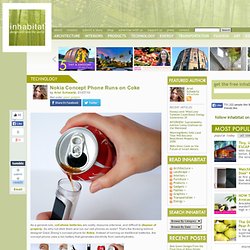
So why not ditch them and run our cell phones on soda? That’s the thinking behind designer Daizi Zheng’s concept phone for Nokia. Instead of running on traditional batteries, the concept phone uses a bio battery that generates electricity from carbohydrates. Fuel cells powered by sugar are nothing new — they’ve been in use for years — but Zheng’s point seems to be that we shouldn’t overlook innovative uses for the products we consume everyday. And of course, maybe Coke does belong in a battery more than it belongs in our bodies. We jut have one question: what about all the energy used to produce Coke? Dezeen via Treehugger.
Grant will help Mackay Sugar make electricity. Energy from Sugar Cane. Zero Gravity Rollercoaster. Zero Gravity Roller Coaster Could Bring Weightless Thrills to Earth. Think about the tallest, wildest roller coaster you've ever been on.
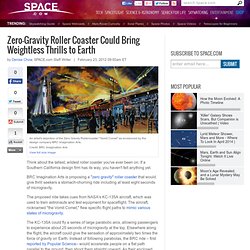
If a Southern California design firm has its way, you haven't felt anything yet. BRC Imagination Arts is proposing a "zero gravity" roller coaster that would give thrill seekers a stomach-churning ride including at least eight seconds of microgravity. The proposed ride takes cues from NASA's KC-135A aircraft, which was used to train astronauts and test equipment for spaceflight. The aircraft, nicknamed "the Vomit Comet," flew specific flight paths to mimic various states of microgravity. The KC-135A could fly a series of large parabolic arcs, allowing passengers to experience about 25 seconds of microgravity at the top.
While conventional roller coasters involve open-air seating, the capsule used in BRC's Vomit Comet will be completely enclosed. A wild ride It will be as if the riders had been tossed in the air and the capsule was simply flying with them, BRC officials said. Why Do People Love to be Scared? Every Halloween, Americans spend millions on scary fun.
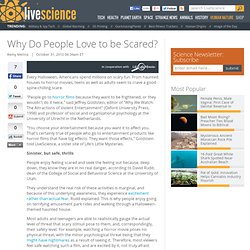
From haunted houses to horror movies, teens as well as adults seem to crave a good spine-chilling scare. "People go to horror films because they want to be frightened, or they wouldn't do it twice," said Jeffrey Goldstein, editor of "Why We Watch: The Attractions of Violent Entertainment" (Oxford University Press, 1998) and professor of social and organizational psychology at the University of Utrecht in the Netherlands. "You choose your entertainment because you want it to affect you. That's certainly true of people who go to entertainment products like horror films that have big effects.